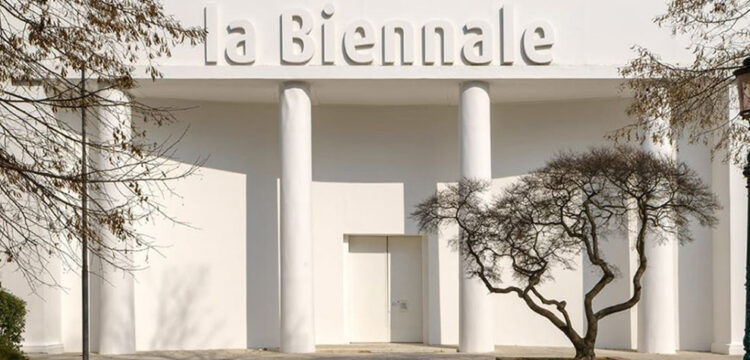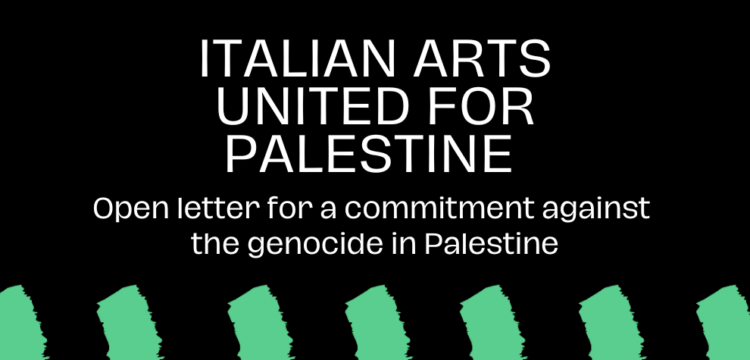No Business As Usual
Boycott the genocide pavilion
NO VISITORS, NO PRESS, NO PARTIES
Art Not Genocide Alliance (ANGA) escalates its ongoing campaign with simultaneous protests outside the Israeli Pavilion and in the city of Venice. ANGA calls for an end to the genocide being perpetrated by Israel against Palestinians in Gaza, an end to the apartheid and an end to the occupation of Palestine. ANGA’s call for the exclusion of Israel, on trial at the International Court of Justice for plausible genocide against Palestinians in Gaza, from this year’s 60th Venice Biennale has gained nearly 24,000 signatures.
The international solidarity and pressure from global arts workers, has resulted in a retreat by the artistic team of the Genocide Pavilion. Contrary to their claims, they have not withdrawn, and the pavilion has not been closed. We do not applaud empty and opportunistic gestures timed for maximum press coverage, and leaving video works on view to the public, while Palestinians are killed by Israel every hour and millions face imminent famine.
ANGA bears witness to the more than 33,797 Palestinians killed in Gaza, more than 76,000 injured, and tens of thousands, presumed dead, who remain trapped beneath the rubble of their former homes. 1.7 million people, 85% of Gaza’s population, have been displaced. 1.1 million Gazans face immediate famine, deliberately imposed by Israel, as it continues to block aid to the people of Gaza. The state of Israel promotes death, cruelty, starvation, and ethnic cleansing. The official presence of Israel at the Biennale disqualifies any discussion of equality, justice, freedom in art as in life. It makes a mockery of the Biennale. There can be no enjoyment of art, no business as usual, during a genocide. [Source ANGA’s press release, 17th April 2024]
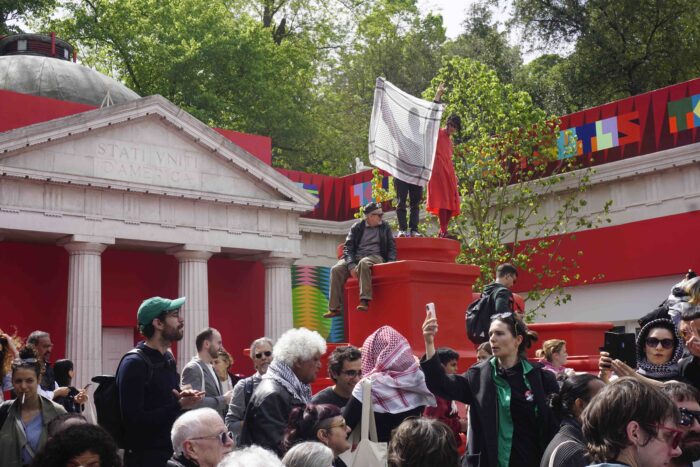
We witnessed your actions across Venice, first of all thanks for organizing – shall we summarize for those who weren’t there what was the message and the intent? What happened simultaneously? What is going to continue to spread slowly?
Our message and intent are always the same: ANGA (Art Not Genocide Alliance) demands an end to the genocide being perpetrated by Israel against Palestinians in Gaza, and an end to the apartheid and occupation of Palestine. ANGA’s call for the exclusion of Israel—currently on trial at the International Court of Justice for plausible genocide against Palestinians in Gaza—from this year’s 60th Venice Biennale has been signed by nearly 24,000 people since 26 February 2024.
The Italian Culture Minister refused ANGA’s request; and the Biennale has failed to condemn Israel, or to exclude its pavilion while Israel commits genocide against the Palestinian people. Historically, the Biennale has excluded the exhibition of apartheid states (South Africa, 1968-1993), stood in solidarity with oppressed nations (Chile, 1974), and publicly denounced states involved in illegal military aggression (Russia, 2022). Israel should not be an exception.
On April 17th at 11.30 am, ANGA escalated its campaign, carrying out two simultaneous protests: the first outside the Israeli Pavilion, and the second on the Rialto Bridge. Inside the Giardini, hundreds of people said “no!” to the presence of a genocidal apartheid state on the world cultural stage of the Biennale, shouting: “SHUT IT DOWN! SHUT IT DOWN! SHUT IT DOWN! WE REFUSE ANYTHING LESS.” We said “no!” to genocide complicit states USA, UK, Germany and France. We stand with Strike Germany and the call to boycott the German Pavilion. We called for a total boycott of the Genocide Pavilion and demanded to shut it down entirely. We say, no window display while Israel is perpetrating genocide in Gaza. Protestors on the Rialto Bridge dropped banners bearing the words “Palestina Libera” and “Let Gaza Live”, calling for Palestinian liberation in the heart of Venice.
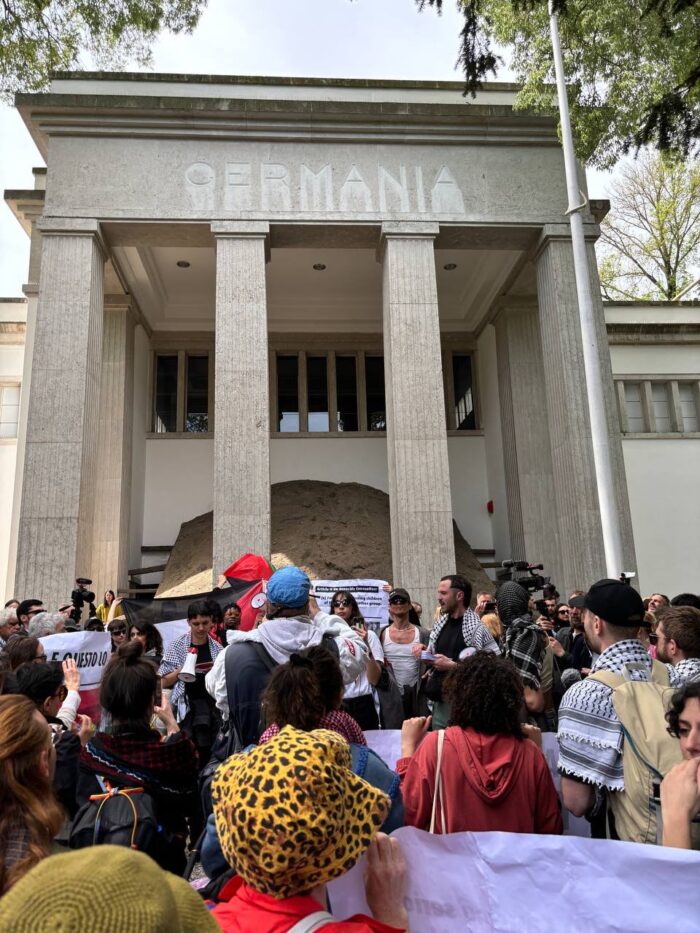
Throughout the day, multiple ANGA poster campaigns were activated around the city, highlighting evidence of Israel’s genocide and celebrating Palestinian artists, including Bayan Abu Nahla, Eltiqa Collective (Dina Matar, Mohammed Al Hawajri, Mohamed Abusal, and Raed Issa), Hadil Alsafadi, Hazem Harb, Khaled Hourani, Malak Mattar, Maram Ali, and Narmeen Hamadeh. And ANGA’s members distributed a free pamphlet that documents the history of protest at the Biennale and a map detailing genocide-complicit nations in the Giardini.
The escalation of the campaign includes the public display of ANGA exhibition labels by artists participating in the Biennale who wish to make visible their collective refusal of the Israeli Pavilion, and to show support for ANGA’s ongoing campaign. Despite the artists’ principled gesture, we have witnessed and denounce the continuous removal and defacement of their exhibition labels. This removal is symptomatic of a climate of censorship and persecution of pro-Palestine voices throughout the Western world; Italy is no different. But we encourage more artists to take a stand. Platforming art that represents a state engaged in ongoing atrocities against Palestinians in Gaza is unacceptable.
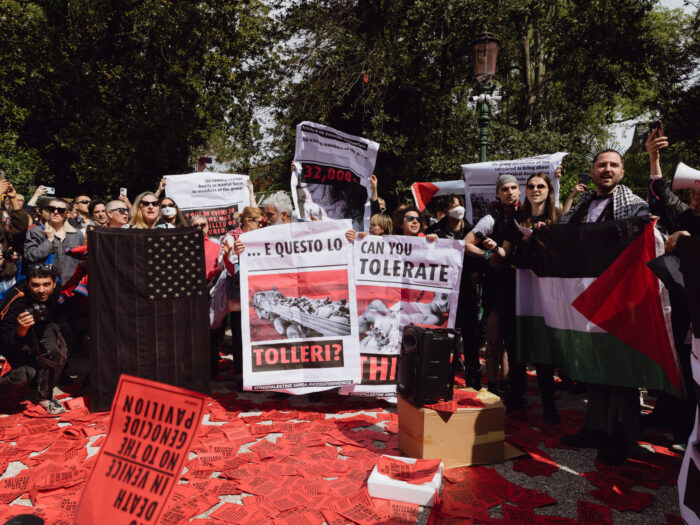
Why is it so important to be present and loud in such an event that the Venice Biennale represents?
The Venice Biennale is the most visible and populated event of the international art calendar; it is a unique moment and when a large and influential sector of the art world descend on one small, shared space. Artists are selected to represent their nation states in pavilions that are usually sponsored by their governments. Israel has a permanent pavilion at the heart of the Giardini, despite the fact that they have created a settler, apartheid regime that has persisted for decades. Weeks ago, Israel was accused by the world’s highest court, the International Court of Justice, of plausibly committing genocide in Gaza. And yet Israel continues to massacre and deliberately starve Gazans and to arm illegal settlers who are terrorizing Palestinians in the West Bank. ANGA has been calling for the Biennale to put pressure on the Israeli pavilion team to pull out in the face of such state inflicted horror. The Biennale pretends it is powerless to do so, despite making vocal statements condemning Russia’s military actions in the run up to the last Biennale of art in 2022. The Israeli artist and curators refused to pull out but, on the evening of the opening, they decided to simply lock the pavilion’s glass doors, thus transitioning the exhibition into a highly visible window display—an opportunistic publicity stunt with disingenuous timing. Israel is still represented at Venice by the artistic team, and the work is still in the Biennale. All who attend and stand by quietly are complicit in art washing Israel’s actions, and Israel is allowed to celebrate its acceptance on the cultural world stage. This is unacceptable. There can be no business as usual during a genocide.
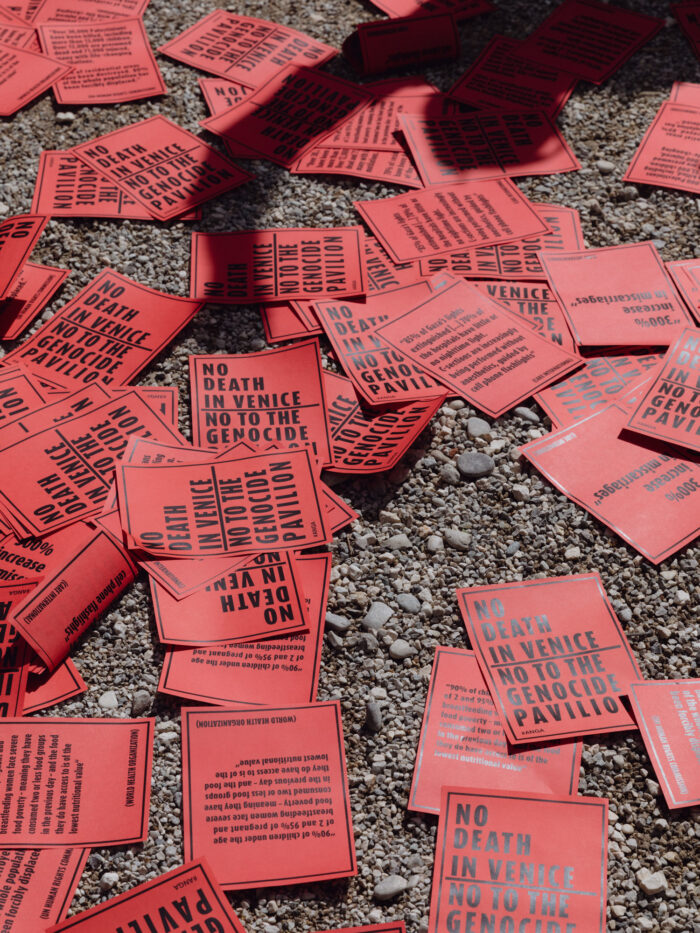
What is the art world’s active role in being complicit with genocide?
Israel is committing war crimes on a huge scale on the one hand, and presenting an artwork that represents the nation at the most prestigious international art event on the other. This simultaneity serves to normalize Israel’s actions and make them acceptable; this is the definition of art washing. Israel’s actions should rightly make it a pariah state. When the art world receives Israel with open arms at the Biennale, Israel is assured that they are seen as civilized and cultured. The art world is thus complicit with genocide when it stays quiet, when it accepts state representation of Israel as inevitable. This is an artworld that willingly joins Israel’s racist agenda.
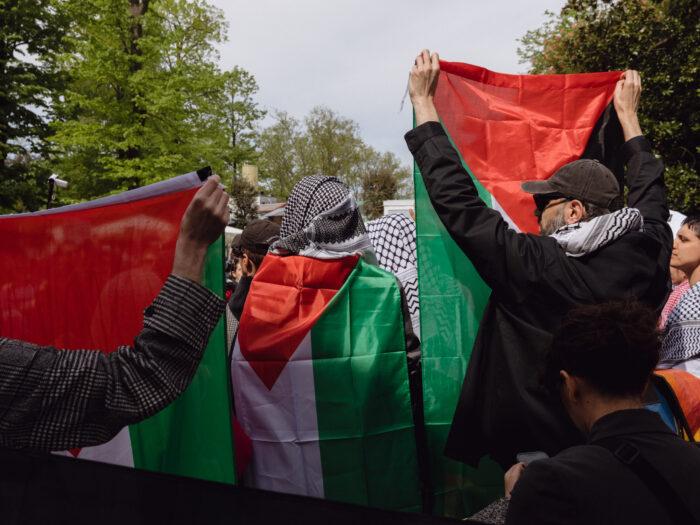
The Israel Pavilion came out with a ridiculous statement yesterday, which was righteously criticized. How did ANGA react to that?
ANGA understands that the Israel Pavilion closed its glass doors as a direct consequence of our collective campaign and widespread international pressure. The artist representing Israel claims she is taking a stance that is critical of her government, yet fails to mention the genocide. The gesture of the exhibition’s closure is false and empty. The artistic team did not shut the pavilion down. The interior is fully lit and visible through the pavilion’s glass walls. The video continues to play the artist’s work, and is now meant to be watched from the outside. On Friday 19 April, a mere day after the opening, visitors were seen entering. Nothing is withheld. There is nothing at stake in this empty gesture that was timed to have maximum press coverage. We demand the Genocide Pavilion is shut down until people have equal rights in historic Palestine.
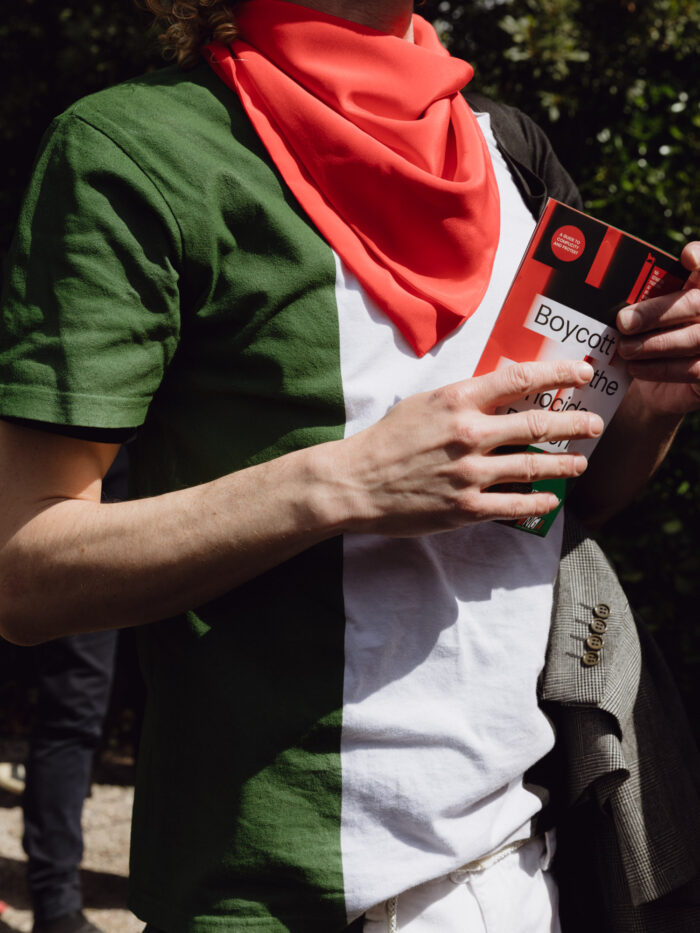
Among the distributed tools there’s A Guide To Complicity and Protest pamphlet. Could you tell us something more about that? What other kinds of tools were offered?
ANGA created a free and handy map for visitors to the Biennale. This essential guide lists genocide-complicit nations exhibiting in the Giardini, charts the incredible history of protest and solidarity at the Biennale, and spotlights Palestinian participation in Venice this year. It also includes meaningful actions that all artists and art workers can take to help shut down the Genocide Pavilion in its entirety, and how to resist genocidal art washing. You can pick these pamphlets up across Venice, and a PDF version is available on our website. Visit www.anga.live/venice.
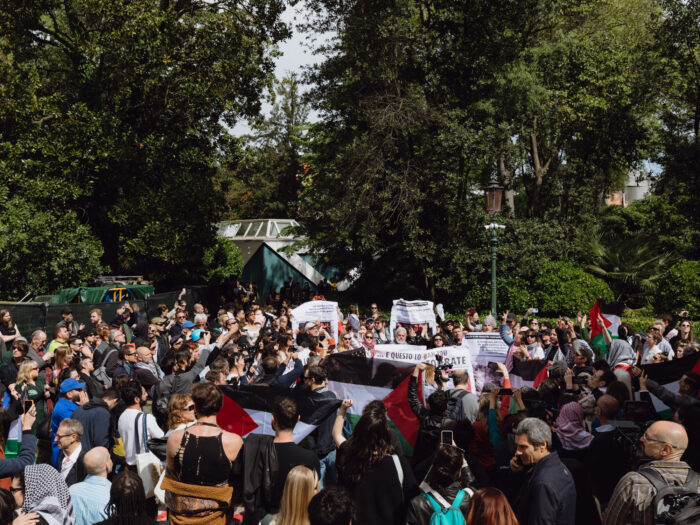
On its Instagram page and in Venice, ANGA hosts The Palestinian Pavilion and its MANIFESTO AGAINST THE STATE OF THE WORLD—“a call for urgent action in response to the ongoing genocide in Gaza, confronting the stark realities shielded by nation-state rhetoric and imperial power”— a printed matter hosted by several pavilions and art spaces. Can we rewrite the manifesto, repeat it, chant it down here again? How does the Palestinian Pavilion take shape otherwise?
Directly quoting the words of members of the Palestinian Pavilion: “This year’s Palestinian Pavilion manifesto was first presented and read out loud during the ANGA action on April 17 at the Giardini together with chants and solidarity statements, amplifying also the concrete poem by Layli Long Soldier, Obligations 2, that is accompanied with.
The manifesto is presented as an A3 Xerox pamphlet and is hosted in collaboration with various pavilions and art/public spaces in Venice that support and distribute this action. It is not a stand alone gesture, but rather expands through an ecosystem of self-organization that claims agency and takes up the Venice biennale as a structure by attempting to leave traces in its public transcript while cracking what it withholds.
Aside from questioning the notion of ‘the state of the world’, it keeps at core the role art and poetry play in a future built on a genocide. The Manifesto is a call to peers and allies to re-imagine and re-write the Palestinian Pavilion and the forms it will emerge from. The Palestinian Pavilion will continue to seek for art and poetry that empowers us, instead of consolidating the prevalence of those in power. We have always known, but we say with renewed certainty that now is the time for art and poetry, manifested in resistance.”




